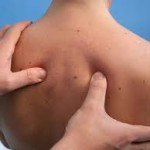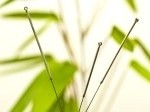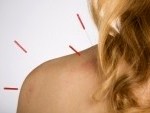Acupuncture Vs Dry Needling.
What’s the difference?
Every week I have several inquiries, asking, “what’s the difference between acupuncture and dry needling”?

The short answer is, “they are like chalk and cheese” specifically in the length of time spent studying/training and learning the skills that yield results and the philosophy that governs these therapies but ultimately the practitioners skill; however there is no difference when it comes to the actual needles used and “this is where the confusion lies”.
Dry needling is a therapy commonly used by Acupuncturists Physiotherapists, Chiropractors, some Massage therapists and is specifically used for muscle pain caused by trigger points (a trigger point is a tight knot in a muscle) only.

The technique is fairly simple, the therapist palpates the area of the body where you are experiencing pain and when the practitioner finds the most tender spot/s an acupuncture needle is inserted into it. Once the needle is in place, the technique involves lifting and thrusting the needle in the affected area until a twitch response is achieved and this method has the ability to release the tight knot in the muscle (trigger point) that is likely causing the pain you are experiencing.
Patients be aware.
Many physiotherapists, chiropractors, podiatrists and remedial massage therapists are advertising their new found skill in dry needling and making claims that it is a modern form of acupuncture.
In 2012 acupuncture became a registered profession in Australia, this has boosted the popularity of acupuncture treatment. Unfortunately the above mentioned practitioners have jumped onto the band wagon and are advertising their dry needling techniques as a modern style of acupuncture which is very misleading.
The claim is that dry needling is more of a western style of acupuncture and they go on to describe it in western medical details. Simply put if they are not a registered acupuncturist, it is against the law to claim they are an acupuncturist or to mislead you into believing they are by the use of certain terminology such as the term ‘acupuncture’ in their description of dry needling, when booking this type of treatment make sure your therapist is a registered acupuncturist by simply asking him / her.

Dry needling is not a new technique in fact it has been around for as long as acupuncture has (2000 plus years) and was the first acupuncture technique ever to be used.
In the system of medicine known as TCM (traditional Chinese medicine) dry needling is known as Ashi point needling and all acupuncturists are taught this technique as part of their acupuncture training.
In the 1970’s a doctor discovered that, if a hypodermic needle was inserted into a trigger point that causes you pain and located in any area of the body, the technique could potentially relieve that pain. With further experimentation and developing this basic technique dry needling was born.
Sometimes called myofascial dry needling, the aim of the practitioner is to identify trigger points around the area that is causing you pain and then insert acupuncture needles into them in order to disperse the trigger point. Basically he had re-invented an old technique by adding modern scientific terms and giving it a new name.
Dry needling can be an effective way of treating neuro-muscular pain syndromes when caused by trigger points, however, it is limited to this only. As previously mentioned most of the confusion about the difference between acupuncture and dry needling lays in the fact that acupuncture needles are used in both therapies.

Dry needling is a simple technique that forms part of acupuncture study and as such dry needling is part of an acupuncturists training, it is not part of physiotherapists or chiropractors training, it has to be learned as a separate course of study once they have graduated, and for these practitioners it is taught over a single weekend, without having to sit any exams or any further supervision which is extremely amateur and dangerous.
Acupuncture on the other hand is a four year full time Bachelor of Health Science and during this four year period students are required to complete 500 clinic hours, where they are scheduled to treat patients using acupuncture techniques in a supervised setting and depending on the patients presenting complaint dry needling may also be included in the treatment plan.
This is a one hour consultation per patient where the student consults with the patient, assesses the health complaint, makes a diagnosis of the presenting complaint and selects which acupuncture-points / combination of points are to be used.
Students then proceed with acupuncture treatment on the patient. As part of the Chinese medicine degree, students also study western medical sciences, gaining a full understanding of the human body.
Acupuncture is a regulated profession which means the only persons legally allowed to use the title “Acupuncturist” are ”registered Acupuncturists” not physiotherapists, chiropractors or massage therapists.
With reference to dry needling, 16 hours of theory and practical training is all that is required for physiotherapists and chiropractors as a minimum standard and no supervision after this short course is required. Dry needling is generally carried out with several needles inserted into a trigger point and is limited to treating muscular pain conditions caused by trigger points.

In the case of acupuncture, the treatment may include needle insertion in areas of the body that are distal to the affected area and in many cases the opposite limb is used for treatment with far fewer needles and patients generally experience superior longer lasting results when compared to dry needling alone and often your acupuncturist may choose to include dry needling in your treatment plan if required.
Acupuncture is based on the Chinese medical system (TCM) which is rich in over 2000 to arguably 5000 years of medical philosophy and has not only stood the test of time, but also 1000s of clinical trials, back it up, to the point where it is now the world’s most used form of natural health care.

Acupuncturists regularly treat digestive issues, menstrual irregularities, depression, anxiety, menopausal symptoms, bells palsy, infertility, trigemenal neuralgia and various addictions, such as cigarette smoking, just to name a few. In 2003 the world Health Organization carried out an audit on acupuncture’s clinical trials and from this audit it was stated that acupuncture can treat over 130 different health conditions and 70 of those are treated more successfully with acupuncture than with drugs and surgery combined and this does not apply to dry needling.
All Acupuncturists in Australia are registered with The Australian Health Practitioners Regulation Agency (AHPRA) and must comply with Australian health standards, these points do not apply to dry needling. In 2012, the law, in a controversial ruling, allowed physiotherapists and also chiropractors to continue performing dry needling after only 16 hours of training, which means these practitioners are now doing dry needling on patients after completing as little as a weekend work shop of training. These courses are not standardized and can vary widely in content and quality and are common in Perth and indeed the whole of Australia. Once the attending student has completed the weekend dry needling training, they jump right into treating patients without any further supervision which is extremely dangerous in the hands of an amateur.

When you make an appointment with a registered acupuncturist you receive acupuncture treatment and this qualifies for a health fund rebate. With reference to physio or chiropractic, this also qualifies for a health fund rebate however dry needling does not. So when you get a health fund rebate from a physio or chiropractor that has performed dry needling on you the rebate you receive is for the physio or chiropractic treatment and not the dry needling.
At Acu-Care Naturopathics Paul Neilson is a qualified and registered Acupuncturist, Naturopath, Remedial therapist and Bowen therapist, with a total of 7 years of study to achieve this, so when you book an appointment you can be sure you are being treated by a fully trained professional in the art of acupuncture and dry needling and you will be receiving the best treatment that holistic medicine has to offer.
Regardless of your medically diagnosed condition acupuncture and natural medicine has something to offer.
If you would like to find out if acupuncture can help your health and well-being then call, 0410094602 or for a quicker response text to 041094602 to discuss your requirements or to find out more about acupuncture please go to our FAQs page. Alternatively give acupuncture a try and make an appointment now.
Best of health
Paul Neilson. CMP. L.Ac. DHM. ND. RT
Acu-Care Naturopathics is central for the suburbs listed below.
Ascot. Ashfield. Bassendean. Bayswater. Beechboro. Belmont. Bentley. Burswood. Cannington. Carlisle. Como. Dianella. East Perth. Forrestfield. Guildford. Highgate. Highwycombe. Inglewood. Kalamunda. Kewdale. Lathlain. Leederville. Lesmurdie. Maylands. Midland. Morley. Mt Lawley. Noranda. North Perth. Perth. Redcliffe. Rivervale. South Perth. St James. Subiaco. Welshpool. West Perth. Tuart Hill. Victoria park. vic park